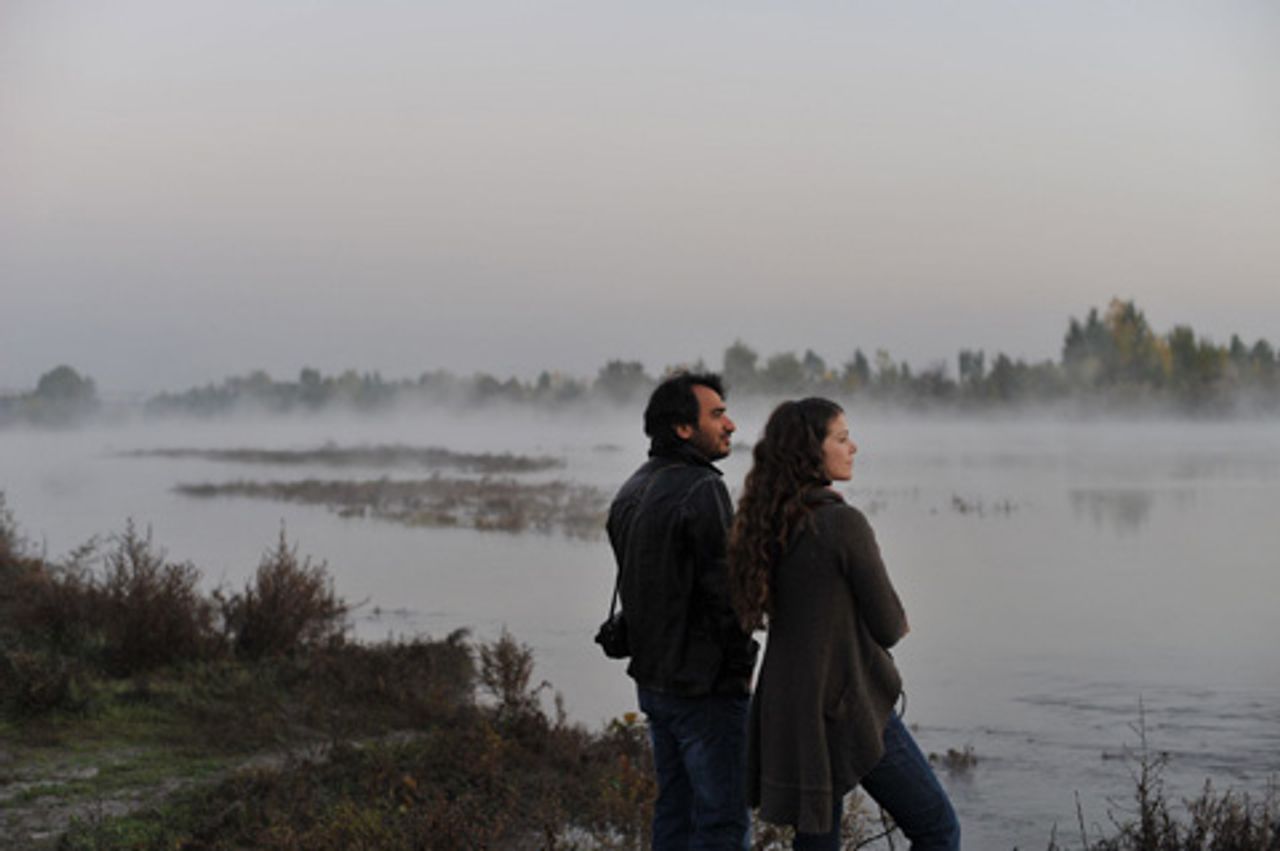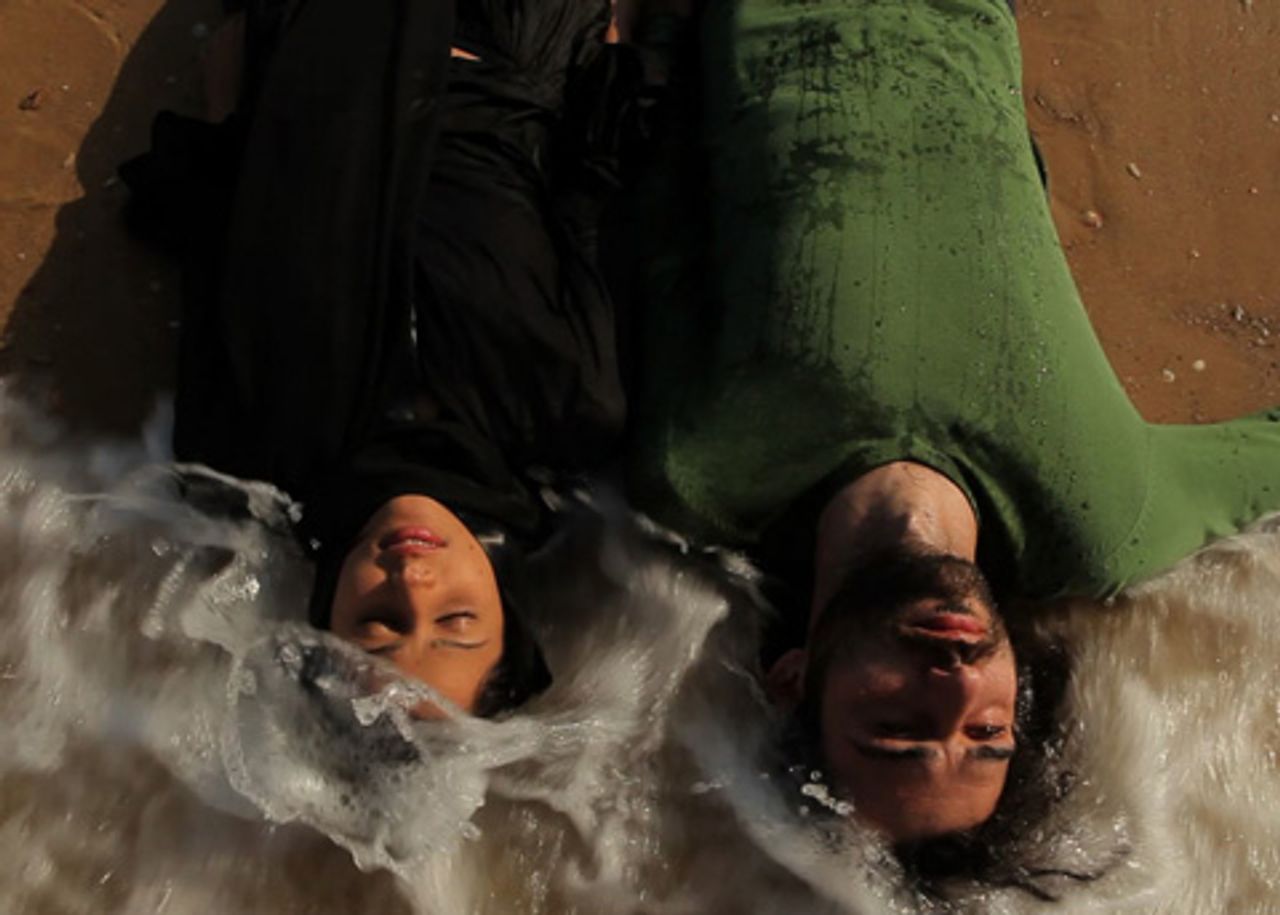This is the latest in a series of articles on the recent Toronto International Film Festival. [Part 1][Part 2][Part 3] [Part 4] [Part 5]
 Think of Me
Think of Me Two major issues stick out in relation to the 2011 Toronto film festival.
First, film writers and directors still find it terribly difficult, by and large, to figure in social life and history as active elements in human psychology and behavior. The notion of a largely or purely personal story playing out “against the background of” this or that great event or series of events became and remains the hallmark of Hollywood filmmaking of a certain type, to the point of cliché.
This sort of thinking and artistic production was encouraged by numerous ideological trends in the post-World War II period, some of them associated with disappointed or demoralized former leftists (e.g., members of the Frankfurt School), who gave up on the working class and social revolution as lost causes and discovered instead that individuals’ life-shaping activity in fact revolved around, for example, the eternal poles of sexual love (Eros) and death (Thanatos). History and social organization were static ‘givens,’ which could be largely set aside when explaining how and why people acted as they did.
All the questions such trends said goodbye to for good—social inequality, mass poverty, popular revolt—never went away of course, but now are re-emerging to the surface with a vengeance. “Real, active” men and women in large numbers are threatening to assert themselves once again as the makers of history.
The anti-Wall Street protests began on September 17, the second-to-last-day of the Toronto film festival. That movement, coming on top of the mass revolt in the Middle East and North Africa, bitter opposition in Greece to the international bankers’ demand, and the upheaval in the state of Wisconsin earlier this year, signals a shift of great importance—for art too.
How rapidly these new, more tumultuous conditions will productively filter into the work of artists, directly and indirectly, consciously and unconsciously, is conditioned by many factors, but influence them they must. At any rate, the artist who refuses to take life at its highest and most intense into serious account will ultimately not be interesting to very many people.
So it is presumably not without significance to encounter this among a director’s notes: “Poverty is the actual antagonist in this film, the ghost in the machine, and I wanted to allude to that constant pressure visually and dramatically.” For such a comment to emerge, still highly unusual in the film world, economic processes have to have reached an advanced stage. Harsh and painful social realities have piled up to the point that they now begin to impress themselves, cutting through the confusion and political difficulties, on serious and sensitive figures as critical, determining facts of life.
The work in question is Think of Me and the director, American Bryan Wizemann. (See “Emotional truth and social truth are what I’m interested in”.) The film recounts a few days in the life of Angela Jacobs (Lauren Ambrose, perhaps best known for Six Feet Under), a single mother in Las Vegas struggling to keep her head above water. Angela works in a call center, resides in a shabby apartment with her young daughter, Sunny (Audrey Scott), and lives, as the production notes suggest, “one paycheck away from complete desperation.”
Her employer (David Conrad) invites her to participate in a real estate deal: if she can come up with $2,000 by the end of the week, he guarantees that her stake will be tripled. She obtains the money from her absent ex-husband, in exchange for dropping any past and future claims for child support.
Angela has meanwhile become friends with a fellow employee, Max (Dylan Baker), who also works part-time as a portrait photographer. Max tells Angela about his childless sister, Louise (Penelope Ann Miller), who has been unable to adopt. Louise comes to Sunny’s eighth birthday party and is won over by the girl. She offers to babysit, tutor and spend time with her.
When the $2,000 disappears during the party, and can’t be found, Angela becomes truly frantic. She tells her boss the next day she doesn’t have the money for the investment deal, and he concludes she was lying all along and fires her. Angela now considers various reckless schemes to raise money, including pretending that her car has been stolen. Max comes forward with an alternative: Louise has fallen for Sunny, and she and her husband want to help the girl by having her come live with them, permanently. The couple is prepared to pay a great deal of money for the opportunity to give Sunny a better life. The offer throws Angela into a deeper crisis.
Bryan Wizemann’s film is sensitively done. Nearly all the dramatic choices seem the right ones. No one is a monster, the conditions of “constant [economic] pressure” are monstrous. “It’s hard right now. I need some help too,” Angela explains a little sadly and bitterly at one point. She does her best, but the odds against her are great, and there is no helping hand.
That Las Vegas, the land of tawdry and manipulated fantasies, is at the center of the foreclosure and joblessness crisis in the US is a reality that should not be lost on anyone seeking to demystify American social life.
The production notes point out that for decades Las Vegas “was the fastest growing city in the country, until the 2008 recession decimated both the gaming industry and the construction boom. The housing vacancy rate quickly rose from 4.5 percent to 7 percent, and now thousands of newly-built condos sit empty, baking in the desert sun. On December 17th, 2010, the week Think of Me wrapped production, the New York Times reported that Nevada had registered the highest unemployment rate in the nation.” How many film productions in recent years have bothered with such mundane details—in reality, the decisive ones?
At a public screening in Toronto, Wizemann referred to the situation in the US as a “second Depression” and dedicated the film to the 40 million Americans living beneath the official poverty line and “people all over the world.” That too is unusual.
At critical moments, Think of Me chooses to treat human beings, even when under great stress, with considerable sympathy and realism. As I noted in my conversation with Wizemann, I was struck—and a little surprised—by the restraint shown in certain sequences. One has come to expect, unhappily, American directors to resort to quasi-psychotic antics in such circumstances.
The actors perform admirably and honestly, and the details of life are accurately presented. In our talk, Wizemann expressed an interest in the drama of the everyday and in his new film has demonstrated that interest artistically and movingly.
Whether Angela’s ultimate course of action involves a momentary psychological leap or not, the viewer will decide for him or herself, but the overall truthfulness of Think of Me is beyond question.
Other films worthy of note
Several other films stood out for their compassion and artistic integrity. Future Lasts Forever from Turkey follows a young woman, Sumru (Gaye Gürsel), a music ethnicologist, as she undertakes a dual mission, to record the elegies of Kurdish survivors of Turkish atrocities and to find, if she can, her lover, a Kurd who has taken up arms. Along the way, she encounters Ahmet, a Kurd, also with a love of music. When he hears her project, he says sardonically, “The Kurds are now of sociological interest.”
 Future Lasts Forever
Future Lasts Forever The film’s most moving and painful moments comprise their recording of mostly Kurdish women describing horrific acts of repression carried out by the Turkish military: houses and animals burned, old and young men murdered, bodies thrown out of helicopters. There are also references to the Armenian genocide of 1915.
Gaye Gürsel gives a deeply affecting performance as Sumru. One believes fully in her horror and concern. The director, Özcan Alper, is obviously no political or artistic naïf. There are several visual references, for example, to Rosa Luxemburg. The talented Soviet poet Andrei Voznesensky (who died in 2010) is cited. The work as a whole has an intellectual and political seriousness and solidity.
Habibi, from American-born Susan Youssef, also has a knowing and substantial, yet poetic, quality. Qays (Kais Nashef) and Layla (Maisa Abd Elhadi), two students from Gaza forced to return home from their studies in the West Bank before completing them, are hopelessly in love. Everything is against them too. Qays, a literature student, is too poor for Layla’s family, who want her to marry a wealthy doctor with a clinic in New York City.
 Habibi
HabibiWhen Layla’s brother, after Israeli settlers murder his best friend, turns to Islamic fundamentalism, things become personally very difficult for her. Qays has been spraypainting verses from Majnun Layla, a seventh-century epic Arabic poem, on the walls of Gaza, which only inflames her family against him all the more. A desperate effort to escape to Europe fails. They return to a tragic end in Gaza.
Layla laments toward the end, “His poems have made me known in Gaza. Otherwise there would be no trace of my existence. People will die, but the poems that Qays has written for me will never die. Qays, I never felt safe with you here in Gaza. I could never open to you or give completely.” They lie down next to each other in the sea, with the surf breaking over them.
The Tall Man, a documentary from Australian director Tony Krawitz, paints a complex picture of the death in police custody of Aborigine Cameron Doomadgee, 36, on Palm Island (Queensland) in November 2004 (See “Australia: Aboriginal death in custody triggers Palm Island riot”; “Australia: Palm Island’s dark history of Aboriginal repression—Part one” and “Australia: Palm Island’s dark history of Aboriginal repression—Part two”).
The publication of a coroner’s report two weeks later, which revealed that Doomadgee had died of internal bleeding—according to witnesses, caused by a policeman’s “bashing”—led to rioting on the island and the burning down of the local police station.
The cop in question, Chris Hurley, was indicted two years later for manslaughter, the first indictment in history of a policeman for the death of an Aboriginal, which led to a virtual police uprising. Hurley was eventually acquitted, or as one of Doomadgee’s relatives puts it, “that rotten bastard got away with f———- murder.” The film honestly sets out the facts, leaving some fairly obvious conclusions for the spectator to draw.
Two films from China, 11 Flowers and Mr. Tree, were of interest, although relatively slight. The first, set in southwest China in 1975, toward the end of the Cultural Revolution, centers on an 11-year-old boy and his friends. The director, Wang Xiaoshuai, has done some interesting work, So Close to Paradise (1998) and Drifters (2003), but as I noted in 2005, his efforts have been “inconsistent. At times Wang seems dedicated to an exposure of the ruthlessness of present-day Chinese economic life, at others, he inclines toward rather conventional, and even self-involved, melodrama.”
11 Flowers, while attractively and authentically done, is noncommittal about the great changes in Chinese life, preferring to concentrate on the boy’s first adult experiences. The latter is drawn peripherally into the sordid drama of a corrupt Communist Party official who rapes a local girl and her brother who revenges her and becomes an outlaw, but it is not clear what wider concerns are at work, if any.
I could repeat virtually word for word what I wrote in regard to Wang’s Shanghai Dreams in 2005, that the “momentous changes are only in the background. The family drama, in the foreground, is rather predictably done, with a largely extraneous subplot … that one feels one has seen before—more than a few times. The events feel reduced to the level of small change, even with a small dose of self-pity. … [O]ne feels, all in all, that greater tragedy lurks in the Chinese situation.”
Mr. Tree (directed by Han Jie) is even slighter, the portrait of a “village idiot” who may possess considerable wisdom. The film carries with it some criticism of the new Chinese capitalists, but not the kind that will draw an awful lot of blood.
Rough Hands (Mohamed Asli) from Morocco, whose central character is a wheeling-and-dealing barber, a latter-day Figaro, with connections throughout a corrupt society and political elite, has some bite and humor. Its final paean to Moroccan self-sufficiency and nationalism, however, limits its value. From South Africa comes Beauty, directed by Oliver Hermanus, the follow-up to his Shirley Adams (2009). Like the latter, Beauty is intelligently and coherently told. A story of sexual obsession and repression and their repercussions, it also stands as a critique of the wealthy Afrikaner community.
The latest work from Sri Lankan filmmaker Vimukthi Jayasundara, (The Forsaken Land, 2005, and Between Two Worlds, 2009), Mushrooms, is his first set in India. More concrete than his second feature, although still occasionally drifting off into rather oxygen-free allegorical space, Mushrooms follows Rahul (Sudip Mukherjee), a Bengali architect returning to Kolkata after years of work in Dubai, where he managed a huge construction site. Jayasundara’s film documents in fragments the architect’s growing despair and alienation, with some degree of compassion and social insight.
British director Michael Winterbottom, unfortunately, seems to turn out films like a “baloney slicer” (to borrow critic Andrew Sarris’s pithy description years ago of American filmmaker William Friedkin’s methods). His latest is a version of Thomas Hardy’s Tess of the d’Urbervilles, set in contemporary India, Trishna. The title character is a poor girl (Freida Pinto) seduced by the wealthy son of a property developer.
The ultimately disastrous fate of the relationship will be apparent to just about every spectator from the outset, and the film is largely an opportunity for lyrical images of Indian vegetation and architecture. Sexual degradation comes into play here, for the most part pointlessly. Winterbottom’s scattershot films contain many pleasing elements, except perhaps any life-and-death artistic and social commitment.
The second issue
The second issue that was brought home by the most recent Toronto festival is this: that many filmmakers, too many, still find representing hopelessness, misanthropy and gratuitous violence simpler and easier, more “natural,” than grappling with the actual complexities and possibilities of life.
A film, for example, such as João Canijo’s Blood of My Blood from Portugal. It is a story set in a slum on the edge of Lisbon and a mother who will sacrifice a great deal for her children. Marcia’s daughter is studying nursing, but has taken up with one of her professors; her son has large and mysterious sums of money, which, we learn, come from the drug trade.
There are elements of everyday life here that ring true, but the director feels the need to stage the most violent and humiliating scenes apparently in an effort to convince us that we are witnessing “life in the raw.” The sequences produce the opposite effect, suggesting that the director has on his mind impressing us and his colleagues more than anything else. This is amateurism and provincialism, frankly.
Tyrannosaur, directed by British actor Paddy Considine, suffers from the same general affliction. The always-riveting Peter Mullan plays an incurably angry working class man, Joseph, who curses and beats his way (or is cursed and beaten) through much of the film. He meets up with Hannah (Olivia Colman), a middle class do-gooder, whom he proceeds to verbally abuse as well. Only she turns out to have an even more cruel situation than he does.
Again, the excessive verbal and physical violence in Tyrannosaur has an effect presumably contrary to what was intended: it makes passive, inures and ultimately has relatively little impact on the spectator. Mullan and Colman give their all, and Considine clearly wants to do something interesting and out of the ordinary, but the film fails largely because it has no real purchase on a social reality that it mistakenly takes for granted and never treats head-on.
Granted, the absence of large social movements in recent years directed against the status quo has reinforced the filmmakers’ skepticism and pessimism. But one should not excuse what is in many cases simply the inability or unwillingness to make sense of extremely contradictory and complicated social and psychological phenomena.
For too long painting everything and everyone in the darkest possible colors has been considered “cutting edge” and even “radical.” It is no such thing. It is often simply taking the easy way out.
To be continued
